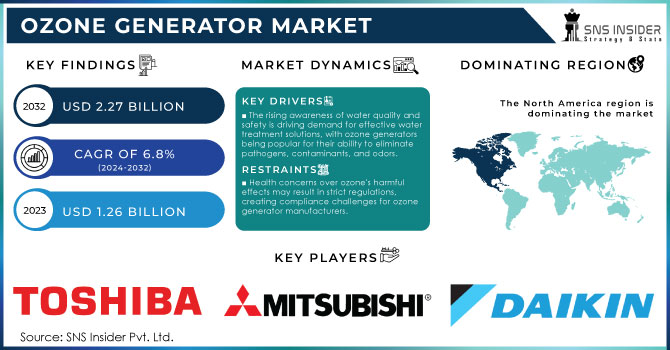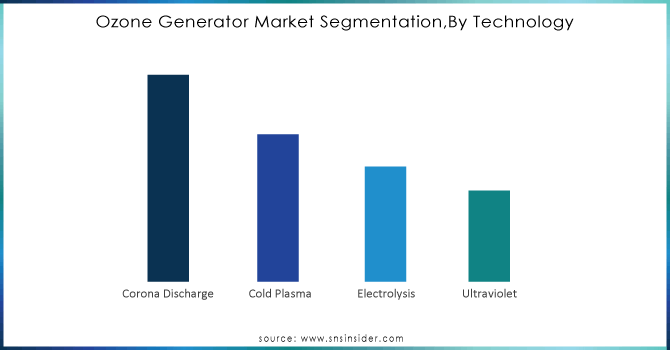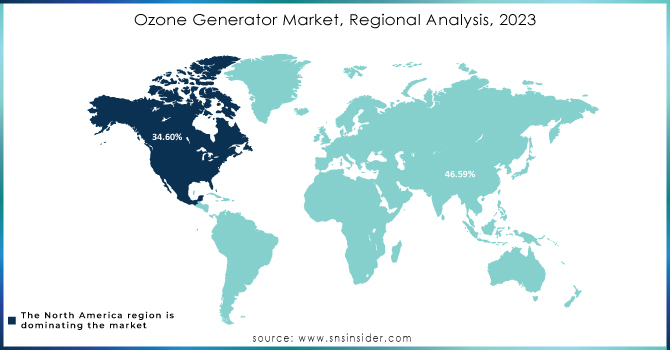Ozone Generator Market Report Scope & Overview:

Get More Information on Ozone Generator Market - Request Sample Report
The Ozone Generator Market size was valued at USD 1.26 Billion in 2023 and is expected to grow at USD 2.27 Billion By 2032 with a growing CAGR of 6.8% over the forecast period of 2024-2032.
The ozone generator market has grown substantially, especially in China where the use of ozone for wastewater treatment has soared over the past two decades. The most recent estimate is that there are over 400 small and medium sized ozone generator manufacturers, with more than 20 companies operating on a semi commercial basis to produce very large units for larger municipal water treatment applications. One of the main reasons ozone generators have observed a surge in popularity like this is the ever-increasing necessity for efficient water treatment solutions (for which the ability of ozone to annihilate agents and bacteria responsible for foul odors has made it into an attractive alternative whether or not traditional techniques were effective). Typically, more affordable ozone sensors have become the established trend, since these are indispensable for a working monitoring of ozone content in air treatment systems. More and more, manufacturers are turning their attention to the kind of technologies that may bring the costs of these sensors down, which will allow for residential consumers to make appointments. Its use in sterilizing hospitals and other healthcare institutions during the coronavirus pandemic has further boosted the market as manufacturers uncover new avenues of revenue.
The ozone generator market also has challenges to cope with, however. Ozone can cause respiratory problems like throat and lung irritation, if you are exposed to high levels for prolonged periods of time, as well as corrosion in a variety of materials. The regulatory concerns related to health have seen a review, which could limit market growth. Nevertheless, these attributes combined with the fact that ozone is microbiocidal and ubiquitous make it an attractive antimicrobial for a variety of applications ranging from public transport to hospitality. Supportive Government Activities across Developed Nations (U.S. and Few European Countries to Accelerate Market Growth) Growing populations and urbanization pressures are boosting expenditures on the rehabilitation or development of water processing units to enable an ever-increasing need concerning freshwater sources. The aforementioned shift in focus toward environmental sustainability and access to clean water is expected to propel the growth of the ozone generator market greatly since it fits with global progress moving toward better water management strategies and nature-friendly technologies.
MARKET DYNAMICS
DRIVERS
- The rising awareness of water quality and safety is driving demand for effective water treatment solutions, with ozone generators being popular for their ability to eliminate pathogens, contaminants, and odors.
Growing consumer as well as industrial awareness about water quality and safety, is a key factor for boosting the demand for efficient water treatment solutions. The reason for this is down to a mixture of health issues, regulatory compliance and awareness of the environmental consequences of poor water quality. The public is also now more aware of the dangers of contaminated water, including pathogens, heavy metals and chemical pollutants leading them to pursue more advanced, reliable ways to assure that their water is safe. Ozone generators rank highly among the numerous treatment technologies that exist, thanks to their potent oxidizing features. Ozone is one of the most reactive forms of oxygen, and kills a diverse range of pathogens, including bacteria, viruses and protozoa making it an appealing disinfectant. Moreover, ozone generators are capable of destroying harmful contaminants and eliminate any unwanted odors so that the water quality is taken at a higher standard without using hazardous by-products. Ozone treatment systems are used in a variety of applications from municipal water treatment plant to residential use because of its versatility. Moreover, with regulatory bodies enhancing the implications of water quality regulations, the use of ozone generators is expected to be compounded, leading at OT overtake other disinfection methods. A sign of the times, this trend reflects a wider dedication to public health and environmental performance as consumers and industry realize that safe, potable water is central to everyday living.
- Increasing regulatory support from governments and environmental agencies promotes ozone technology as a safe alternative to traditional chemical treatments, encouraging industries to adopt ozone generators for cleaning and disinfection.
This factor also acts as an accelerator for ozone technology adoption compared to the conventional chemical process and also encourages and supports large investments are made by governmental and other environment agencies on this power osneration method. One of the main drivers behind this change is an increasing awareness around the environmental impact of chemical disinfectants, which are also known to be not without risks for health and harmful to the environment. Ozone is a strong oxidizing agent used in cleaning and disinfection processes for for example food processing, health care and water treatment. The government has made it legal to use ozone generators and infectious control guidelines are there which prescribe ozone machines as one of the best options for pathogen killing without being hazardous residues. With regulatory pressure on industries to comply with such regulations and to push for greener alternatives, the introduction of ozone technology could not only satisfy both requirements in terms of safety and efficacy but also at a value that prioritizes their stand in sustainability. Appropriate regulation supports a wider-scale adoption of ozone generators, encouraging the retail market, and assisting with innovation.
RESTRAIN
- Health concerns over ozone's harmful effects at high concentrations can lead to strict regulations that limit the use of ozone generators, presenting compliance challenges for manufacturers.
The human health has become a major global concern regarding the harmful effects of ozone at higher concentrations by legislative bodies. At ground-level, ozone is a concern because of its harmful effects on health. High ozone levels can cause breathing problems, aggravate asthma and other lung diseases, and damage lung tissue that reduces lung function. This has led many governments to create strict regulations for reducing ozone emissions, which include the use of ozone generators using in industrial processes for purification and deodorization. Manufacturers face compliance issues because they have to comply with strict local and international laws, at times investing in expensive technology that is out-of-date by the time it gets installed. Those not in compliance can face hefty fines, closures, and reputational harm for a company. As a result, the manufacturers needed to spend thousands of hours and hundreds of thousands of dollars learning how to comply with these new regulations in order to be able to stay in business.
Key Market Segmentation
By Technology
The corona discharge segment accounted for the largest revenue share of 43.2% in 2023. Over the next few years, it is expected to continue growing at a notable CAGR due to the fact that these generators create pure ozone without any chemicals or gases. Moreover, they can be purchased at affordable prices and generate therapeutic/medical-quality ozone, which increases their popularity.

Need any customization research on Ozone Generator Market - Enquiry Now
By Application
The wastewater treatment segment accounted for the largest revenue share of 46.2% in 2023. Ozone generators are primarily utilized in water and wastewater treatment facilities due to ozone's superior ability to eliminate bacteria and viruses. Moreover, ozonation requires less time for contact and does not result in any leftover substances. Anticipated growth in the demand for wastewater treatment products is linked to reduced safety concerns during handling and shipping, as well as low maintenance expenses.
By End-Use
The municipal segment accounted for the largest revenue share of 52.21% in 2023Due to its strong oxidizing power and capability to oxidize heavy metals, the sector is projected to continue growing at a significant CAGR in the coming years with increasing demand for its products.
REGIONAL ANALYSIS
North America region dominated the market share over 34.6% in 2023, Because of the focus on wastewater treatment and the need for air treatment systems to clean strong odors, get rid of mold, and eliminate smoke smells. The U.S. implemented a fresh legislation on Public-Private Partnerships (PPP) to promote investments in upgrades and new construction of domestic water purification plants. The effort to promote local investments in water treatment is expected to positively impact the ozone generator market for the entire forecasted period.
Asia Pacific is expected to grow at the fastest CAGR during the forecast period. Pollution of water is a significant environmental issue in this area. The dumping of industrial waste, raw sewage, and improper farming techniques contribute to the contamination of rivers and other water sources. Additionally, the inadequate sewerage network coverage and lack of wastewater treatment plants are anticipated to exacerbate the water pollution in the region.

KEY PLAYERS
Some of the major key players of Ozone Generator Market
- Mitsubishi: Mitsubishi Ozone Generator Series (Industrial ozone generators for water treatment and air purification)
- Toshiba: Toshiba Ozone Generators (Ozone generation systems for wastewater treatment)
- Daikin: Daikin Ozone Generators (Air conditioning systems with built-in ozone generation for odor control)
- SUEZ: SUEZ Ozone Solutions (Ozone systems for water and wastewater treatment)
- Ozone Tech Systems: OTS Ozone Generators (Compact ozone generators for air and water treatment)
- Primozone: Primozone Ozone Generator (Ozone generation systems designed for various industrial applications)
- EBARA Technologies:EBARA Ozone Generators (Ozone systems for industrial wastewater treatment)
- Lenntech: Lenntech Ozone Generators (Modular ozone systems for water purification)
- DEL Ozone: DEL Ozone Generator Models (Ozone systems for swimming pool sanitation and water treatment)
- METAWATER: METAWATER Ozone Generator (Ozone solutions for drinking water treatment)
- ESCO International: ESCO Ozone Generators (Systems for municipal and industrial wastewater treatment)
- Oxyzone: Oxyzone Ozone Generator Series (Compact systems for air and water treatment)
- Corotec: Corotec Ozone Generator (Ozone generation systems for various applications including food processing)
- Ozonetek: Ozonetek Ozone Generators (High-efficiency ozone generators for industrial applications)
- Aqua Science: Aqua Science Ozone Systems (Ozone generators for water treatment and odor control)
- Ozonia: Ozonia Ozone Generators (Advanced ozone generation systems for various industrial applications)
- HITACHI: HITACHI Ozone Generators (Ozone systems integrated into HVAC applications)
- SICK AG: (Ozone detection and generation technology)
- Blue Sky Water Technologies: Blue Sky Ozone Systems (Ozone generators for air and water purification)
- BWT: (Ozone solutions for water treatment in various industries)
RECENT DEVELOPMENTS
In May 2023: Xylem, a U.S.-based company providing water solutions, acquired Evoqua Water Technologies LLC, a key player in mission-critical water treatment products and services, through an all-stock transaction valued at nearly USD 7.5 billion. This acquisition has resulted in the availability of the most advanced platform of capabilities worldwide, poised to address the pressing water needs of Xylem's consumers and communities.
In April 2023: Fresh Mouth announced the launch of its new ozone generator, which also functions as a hydrogenated water producer. This generator is designed to safely and efficiently clean and sanitize the mouth. The device generates ozone, which eliminates harmful bacteria, viruses, and fungi responsible for bad breath, gum infections, and other oral health issues.
| Report Attributes | Details |
|---|---|
| Market Size in 2023 | USD 1.26 Billion |
| Market Size by 2032 | USD 2.27 Billion |
| CAGR | CAGR of 6.8% From 2024 to 2032 |
| Base Year | 2023 |
| Forecast Period | 2024-2032 |
| Historical Data | 2020-2022 |
| Report Scope & Coverage | Market Size, Segments Analysis, Competitive Landscape, Regional Analysis, DROC & SWOT Analysis, Forecast Outlook |
| Key Segments | • By Technology(Corona Discharge, Cold Plasma, Electrolysis, Ultraviolet) • By Application(Wastewater Treatment, Air Treatment, Laboratory & Medical Equipment, Others) • By End-Use(Municipal, Industrial, Commercial, Residential) |
| Regional Analysis/Coverage | North America (US, Canada, Mexico), Europe (Eastern Europe [Poland, Romania, Hungary, Turkey, Rest of Eastern Europe] Western Europe] Germany, France, UK, Italy, Spain, Netherlands, Switzerland, Austria, Rest of Western Europe]), Asia Pacific (China, India, Japan, South Korea, Vietnam, Singapore, Australia, Rest of Asia Pacific), Middle East & Africa (Middle East [UAE, Egypt, Saudi Arabia, Qatar, Rest of Middle East], Africa [Nigeria, South Africa, Rest of Africa], Latin America (Brazil, Argentina, Colombia, Rest of Latin America) |
| Company Profiles | Mitsubishi, Toshiba, Daikin, SUEZ, Ozone Tech Systems, Primozone, EBARA Technologies, Lenntech, DEL Ozone, METAWATER, ESCO International, Oxyzone, Corotec, Ozonetek, Aqua Science, Ozonia, HITACHI, SICK AG, Blue Sky Water Technologies, BWT |
| Key Drivers | • The rising awareness of water quality and safety is driving demand for effective water treatment solutions, with ozone generators being popular for their ability to eliminate pathogens, contaminants, and odors. • Increasing regulatory support from governments and environmental agencies promotes ozone technology as a safe alternative to traditional chemical treatments, encouraging industries to adopt ozone generators for cleaning and disinfection. |
| RESTRAINTS | • Health concerns over ozone's harmful effects at high concentrations can lead to strict regulations that limit the use of ozone generators, presenting compliance challenges for manufacturers. |

